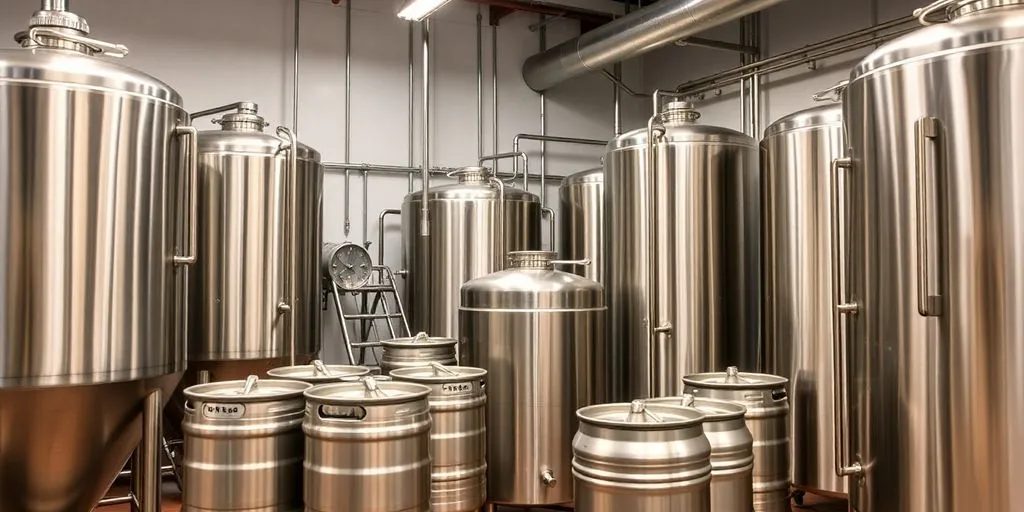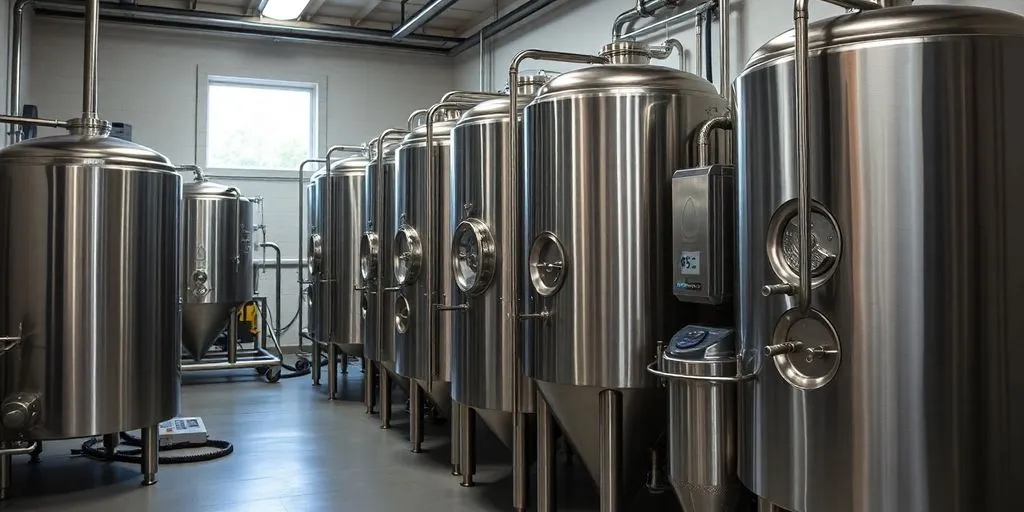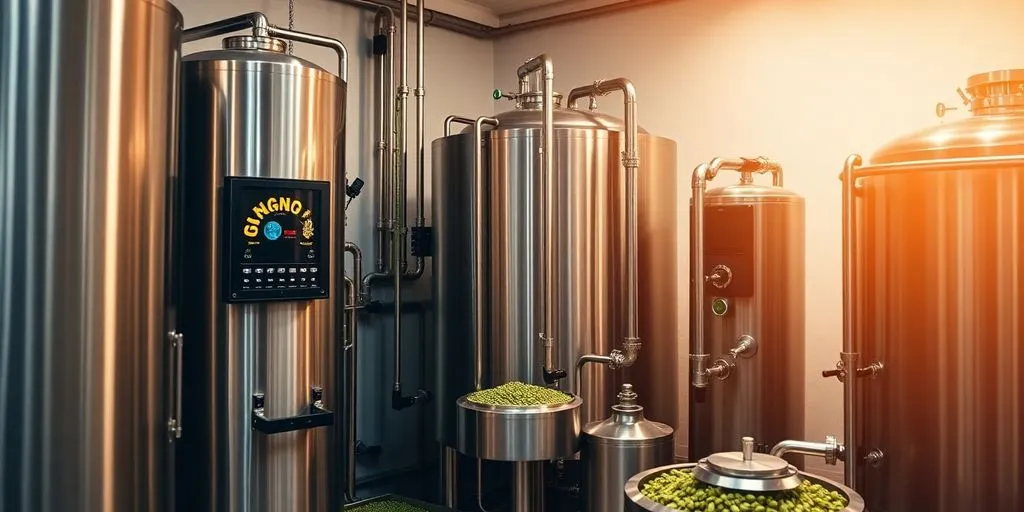Starting a nanobrewery is an exciting venture for any aspiring brewer looking to brew craft beer on a small scale. This comprehensive guide will walk you through everything you need to know about nano brewery equipment, from understanding what a nanobrewery is to choosing the right equipment and turning your brewing dreams into reality. Whether you’re a homebrewer ready to step up or an entrepreneur entering the booming craft beer industry, this article is a must-read.

What Is a Nanobrewery and Why Start One?
A nanobrewery is a small-scale brewery that produces beer in batches of three barrels or less. Unlike larger breweries, nanobreweries operate on a smaller scale, making it an excellent startup option for passionate brewers. Investing in nano brewing allows you to enter the brewing industry with lower startup costs and provides flexibility in experimenting with different beer recipes.
Why Start a Nanobrewery?
- Lower Investment: With less equipment and smaller space requirements, the initial equipment investment is significantly reduced.
- Creative Freedom: Brew small batches and experiment with various types of beer to find your niche.
- Community Engagement: Serve your local customer base and build a loyal following in your area.
Starting a nanobrewery is an opportunity to turn your passion for beer brewing into a thriving business. With the rising popularity of craft beer, there’s a growing market eager to try unique and locally brewed beers.
Essential Nano Brewery Equipment Needed
When starting a nanobrewery, having the right equipment is crucial. Here’s a list of the essential brewery equipment you’ll need:
1. Brewing System
The brewing system is the heart of your nanobrewery. This typically includes:
- Mash Tun: Where crushed grains and water mix to convert starches into fermentable sugars through the mashing process.
- Brew Kettle (Kettle): Where the wort is boiled, and hops are added.
- Hot Liquor Tank: Used to heat water for mashing and sparging.
Explore 2 Vessel Brewhouse Systems
2. Fermentation Tanks
After boiling, the wort is cooled and transferred to fermentation tanks. Here, yeast is added to begin the fermentation process, transforming sugars into alcohol and CO₂.
- Conical Fermenters: Preferred for ease of yeast collection and cleaning.
3. Temperature Control Systems
Maintaining proper temperature control during fermentation is vital. Temperature affects yeast activity and, ultimately, the flavor and quality of your craft beer.
4. Bright Tanks
Used for aging, clarification, and carbonation of beer before packaging.
5. Packaging Equipment
Once fermentation is complete, you’ll need packaging equipment such as:
- Keg Filling Machines
- Bottle Filling Machines
- Can Filling Machines
6. Miscellaneous Equipment
- Pumps and Hoses
- Cleaning Equipment
- Grain Milling Equipment
- Wort Chillers
Investing in quality equipment ensures efficiency and consistency in your brewing process.
How to Choose the Right Nano Brewing System
Choosing the right nano brewing system can be overwhelming. Consider the following factors to make an informed decision:
Batch Size and Production Volume
Determine how many barrels you plan to produce per batch. This will influence the size and capacity of your brewing system. Remember, a nanobrewery typically produces batches of three barrels or less.
Space and Layout
Assess your brewery space. Ensure that the equipment fits comfortably and allows for efficient workflow. Optimize the brewery setup to make the best use of available space.
Budget Constraints
Your equipment investment should align with your budget. Consider both the initial equipment cost and long-term operational expenses.
Equipment Manufacturer
Select a reliable equipment manufacturer that provides equipment tailored to your needs. Micet offers a range of nano brewery equipment designed for efficiency and scalability.
Contact Micet for Equipment Solutions
Future Expansion Plans
Consider whether you plan to expand your brewery in the future. Choosing equipment that can scale with your business can save costs in the long run.
Understanding the Brewing Process in Nano Breweries
The brewing process in nanobreweries follows similar steps to larger breweries but on a smaller scale:
1. Mashing
In the mash tun, crushed grains are mixed with water. The heat activates enzymes that convert starches into fermentable sugars, creating a sugary liquid called wort.
2. Lautering
The wort is separated from the grain solids. This step involves filtering the wort through the grain bed in the mash tun.
3. Boiling
The wort is transferred to the brew kettle and boiled. Hops are added at various times to impart bitterness, flavor, and aroma.
4. Cooling
After boiling, the wort is rapidly cooled to a temperature suitable for fermentation.
5. Fermentation
The cooled wort is moved to fermentation tanks, and yeast is added. The yeast consumes the sugars, producing alcohol and CO₂ in the process known as fermentation.
6. Conditioning
Once fermentation is complete, the beer is conditioned, allowing flavors to mature and any unwanted compounds to settle.
7. Packaging
The finished beer is packaged using packaging equipment, ready to be enjoyed by your customers.
Understanding each step deeply allows you to fine-tune your process and produce exceptional craft beer consistently.

Equipment Costs: What to Expect When Starting a Nanobrewery
Startup costs for a nanobrewery can vary widely based on several factors. Here’s a breakdown of where your investment might go:
Brewing Equipment
- Nano Brewing Equipment: Costs can range from $10,000 to $100,000 depending on size and complexity.
- Used vs. New Equipment: While used equipment might be cheaper upfront, new equipment often offers better warranties and technology.
Facility Costs
- Lease or Purchase Expenses: Costs depend on location and size.
- Renovations: Modifying the space to meet brewing needs.
Licensing and Permits
- Brewing Licenses: Necessary legal documentation can cost between $500 and $5,000.
Operating Expenses
- Ingredients: Malt, hops, yeast, and other brewing materials.
- Utilities: Water, electricity, and gas.
- Labor: If hiring additional staff.
Creating a comprehensive business plan helps in assessing these costs and planning your equipment investment wisely.
Selecting the Right Equipment Manufacturer
Choosing a reliable equipment supplier is paramount to your nanobrewery’s success. Here’s why Micet is a preferred choice:
Expertise and Experience
- Professional Brewing Equipment Manufacturer: Micet specializes in producing high-quality commercial brewing equipment.
Customized Solutions
- Equipment Tailored to Your Needs: Micet works with you to design equipment that fits your specific requirements.
Quality Assurance
- Stainless Steel Equipment: Durable and designed to meet industry standards.
After-Sales Support
- Ongoing Support: Micet provides technical support and maintenance services.
Learn More About Micet’s Equipment
How Temperature Control Affects Your Nanobrewery
Temperature control is a critical factor in the brewing process:
Fermentation
- Yeast Activity: Yeast strains have optimal temperature ranges. Deviations can lead to off-flavors or stalled fermentation.
Mashing
- Enzyme Efficiency: Specific temperatures activate enzymes that convert starches into sugars.
Benefits of Proper Temperature Control
- Consistent Quality: Ensures each batch meets your quality standards.
- Efficiency: Optimizes fermentation times and reduces risks of fermentation failures.
Investing in reliable temperature control systems is essential for any nanobrewery aiming for professional brewing standards.
Nano Brewing vs. Microbrewery: What’s the Difference?
Though both nanobreweries and microbreweries produce craft beer, they differ in scale and operation:
Production Volume
- Nanobrewery: Produces less than 3 barrels per batch.
- Microbrewery: Can produce up to 15,000 barrels annually.
Equipment Size
- Nano Brewing Equipment: Designed for small spaces and smaller batches.
- Microbrewery Equipment: Larger systems requiring more space and investment.
Market Reach
- Nanobreweries: Primarily serve the local market.
- Microbreweries: Distribute regionally or nationally.
Understanding these differences helps you choose the right path for your brewing ambitions.

Tips for Expanding Your Brewery from Nano Level
As your nanobrewery grows, you may consider expanding. Here are some tips:
Evaluate Demand
- Customer Base Growth: Ensure there’s enough demand to justify expansion.
Plan Equipment Upgrades
- Scalable Equipment: Invest in equipment that’s modular or can be easily upgraded.
- Capacity Planning: Choose fermenters and brewhouses with larger capacities.
Optimize Space
- Efficient Layouts: Redesign your brewery space for better workflow and additional equipment.
Financial Planning
- Investment Analysis: Consider the equipment cost versus projected revenue increases.
Micet can assist you in this process, offering expertise and equipment solutions to facilitate your brewery’s growth.
Explore Commercial Brewery Equipment
Contact Micet: Your Trusted Equipment Supplier
Ready to start your nanobrewery or expand your brewing capacity? Micet is here to help with:
- Professional Brewing Equipment: From nano brewing equipment to commercial brewing equipment.
- Customized Solutions: Equipment designed to meet your specific needs.
- Expert Support: Guidance through every step of your brewing journey.
Contact Micet Today to get started.
Frequently Asked Questions
To start a nanobrewery, you’ll need essential brewing equipment including a brewing system (mash tun, brew kettle), fermentation tanks, temperature control systems, and packaging equipment.
A nanobrewery can operate in a relatively small space, sometimes under 1,000 square feet. The exact size depends on your equipment and production goals.
Startup costs vary but can range from $50,000 to $250,000, including equipment, facility costs, licenses, and initial operating expenses.
Yes, many nanobreweries plan for future expansion. Upgrading equipment and optimizing brewery space can facilitate growth into a microbrewery.
Temperature control is crucial at all stages of the brewing process, affecting yeast activity, enzyme efficiency during mashing, and overall beer quality.
Micet offers high-quality, customizable brewing equipment designed for efficiency and scalability, along with expert support throughout your brewing journey.
Key Takeaways
- Understand the Basics: Know what a nanobrewery is and why it’s a viable business option.
- Invest Wisely in Equipment: Choose the right nano brewing equipment based on your needs and budget.
- Master the Brewing Process: A deep understanding ensures consistency and quality in your craft beer.
- Plan for Costs and Expansion: Be prepared for initial costs and future growth opportunities.
- Partner with the Right Supplier: Micet provides professional equipment and support.
Embarking on your brewing journey requires passion, planning, and the right partners. With careful preparation and dedication, your nanobrewery can flourish in the thriving craft beer industry.
